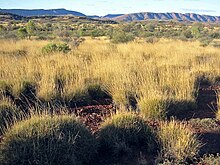Outback

As Outback are Australian regions referred to are far from civilization. It covers almost three-quarters of the area of Australia and extends mainly across the Northern Territory and Western Australia as well as parts of Queensland , New South Wales and South Australia .
The outback includes the most varied of landscape formations and climatic zones. Large areas of the extremely dry outback of Western Australia, where sometimes no rain falls for years and temperatures over 50 ° C in summer, are completely inaccessible. The Queensland outback, on the other hand, consists partly of pristine tropical rainforest . The tropical forests of the Top End , the Kakadu National Park and the deserts of the Red Center with the Ulu r u – Kata-Tju t a National Park , in the center of which is the famous monolith Ulu r u , also called Ayers Rock , are well developed for tourism . located; also known are the Karlu Karlu (Devil's Marbles) .
history
It is estimated that the interior of Australia has been inhabited for about 40,000 to 50,000 years by Aborigines who immigrated from Southeast Asia / Indonesia. The historical exploration begins with the first forays of European explorers through the interior of the continent:
- Edward John Eyre , an English sheep farmer, crossed the Nullarbor Plain from Adelaide to Western Australia in 1840/1841 . The large salt lake Lake Eyre is named after him.
- In 1844/1845 John McDouall Stuart made his first forays through Central Australia in search of water. In 1862 he successfully crossed the continent from south to north. The Stuart Highway bears his name.
- Ludwig Leichhardt , a German explorer, traveled 4,800 kilometers overland from the east to the north coast in 1844/1845. In 1848 he set out on an east-west crossing of the continent, from which he never returned.
- The Burke and Wills expedition in the years 1860 and 1861 ended in disaster.
- Ernest Giles , who discovered the Kata Tju t a , was the first European to cross the deserts of Western Australia in 1873; his companion Alfred Gibson , after whom the Gibson Desert is named, was killed. In the same year William Gosse was the first European at Ulu r u .
Infrastructural characteristics
- A few paved main roads (highways) run through the outback; apart from these stretches, sand slopes in the desert and rainforest are only accessible with all-wheel drive.
- Individual cattle farms and supply stations with a few houses. Often the gas station, supermarket, repair shop, bank, post office, motel and bar are all housed in a single building, the roadhouse .
- The children receive distance learning via radio ( School of the Air ) and the Internet, and the Royal Flying Doctor Service (RFDS) is called in the event of illness .
- Camels were introduced to the fifth continent as desert animals from the Middle East in 1870. Today they are kept on farms and serve not only as a self-sufficient supply but also as a tourist attraction.
- Of the approximately 300,000 Aborigines (around 1.5 percent of the total population of Australia), around 20 percent live in the outback, most of them in reservations (the few still traditionally as nomads or semi-nomads).
- Communicative events such as the Birdsville horse race have local cult status.
- Road trains , usually with a cow catcher mounted on the front (in Australia often referred to as the "roo bar" - kangaroo catcher ), ensure overland transport.
Understanding of terms
In tourist parlance outside of Australia, the understanding of the Red Center as pars pro toto for the outback has established itself because it has become accessible not only for globetrotters, but also for package tourists thanks to good infrastructural development. In Australia, the term "outback" was first used in print in 1869 and at the time meant "west of Wagga Wagga " in the state of New South Wales.
For Australians, the outback is a very flexible term, the interpretation of which varies greatly depending on where you live. For example B. for the residents of the metropolis of Sydney already the Blue Mountains (about 60 kilometers west of Sydney), Wollongong (about 100 kilometers south of Sydney) and Newcastle (about 100 kilometers north of Sydney) to the outback (in the bush) . Alice Springs has a tourist outback flair, but does not see itself as an outback among the local population.
In terms of the use of the term, the outback can be compared with the Argentine pampas , the South African High Veld or the New Zealand High Country . The real outback are the self-sufficient communities and self-sufficient farms away from the urban centers.
Occasionally, the word “outback” is also used on radio to designate the surrounding area of larger cities in traffic.
Web links
- Underground desert paradise. On: Wissenschaft.de from August 6, 2005
Individual evidence
- ↑ Sheena M. Coupe (ed.): Frontier Country - Australias Outback Heritage , Vol. 1. Weldon Russell Publishing, Willoughby 1989, ISBN 1-875202-01-3 , pp. 36 ff.

